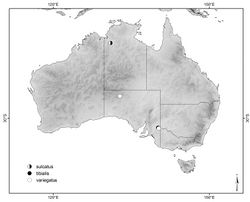Larrisson sulcatus
| Notice: | This page is derived from the original publication listed below, whose author(s) should always be credited. Further contributors may edit and improve the content of this page and, consequently, need to be credited as well (see page history). Any assessment of factual correctness requires a careful review of the original article as well as of subsequent contributions.
If you are uncertain whether your planned contribution is correct or not, we suggest that you use the associated discussion page instead of editing the page directly. This page should be cited as follows (rationale):
Citation formats to copy and paste
BibTeX: @article{Pulawski2012JournalofHymenopteraResearch25, RIS/ Endnote: TY - JOUR Wikipedia/ Citizendium: <ref name="Pulawski2012Journal of Hymenoptera Research25">{{Citation See also the citation download page at the journal. |
Ordo: Hymenoptera
Familia: Crabronidae
Genus: Larrisson
Name
Larrisson sulcatus Pulawski sp. n. – Wikispecies link – ZooBank link – Pensoft Profile
Name–derivation
Sulcatus, a Latin masculine adjective meaning furrowed. With reference to a pair of sulci on the posterior propodeal surface of this species.
Recognition
The male of sulcatus differs from all other species of Larrisson by the presence of a pair of longitudinal sulci on the posterior propodeal surface that are convergent ventrad (Fig. 17a), and a triangular rather than open anteriorly second submarginal cell (Fig. 17b). The female is unknown.
Description (based on holotype only)
Male. Width of face across clypeus and vertex = 60:58, least interocular distance 44. Orbital fovea ill defined, narrower than half ocellocular distance. Clypeal lobe only slightly prominent, its free margin arcuate, obtusely angulate laterally. Scapal basin impunctate. Length of scape (excluding radicle) 2.2 × width, length equal to flagellomeres I–IV + half V combined. Mesopleural punctures less than one diameter apart; impunctate, low tubercle present in front of midcoxa; mesothoracic venter densely punctate throughout (punctures less than one diameter apart). Metanotum with median tubercle. Propodeal side with well-defined ridges; posterior surface ridged mesodorsally, finely rugose mesoventrally, with pair of longitudinal sulci that are converging ventrad (Fig. 17a). Forewing vein M diverging from M+Cu distad of cu-a by about 0.5 length of cu-a; second submarginal cell triangular (Fig. 17b). Outer surface of hindtibia impunctate and asetose between spines along dorsal margin. Tergum I concave basally, concavity with well-defined median line.
Setae all silvery except golden beneath midocellus, appressed on head, thorax, propodeum, and legs, nearly completely concealing integument on clypeus (except glabrous ventral portion of median lobe) and on ventral half of frons laterally (except for glabrous scapal basin), not concealing integument on mesopleuron or mesothoracic venter, not forming well-defined apical fasciae on terga. Hindfemoral venter and inner (= posterior) surface setose.
Head, thorax, and propodeum black except the following are pale yellow: scape, part of pedicel, mandible basally (apex dark brown), pronotal lobe, and humeral plate of wing base; flagellum black dorsally, brown ventrally (two apical flagellomeres all brown). Femora black basally, yellow apically; tibiae and tarsi yellow.
Posterior mandibular margin not expanded between base and notch, inner margin with small tooth near midlength. Flagellum cylindrical; dorsal length of flagellomere I about equal to apical width. Propodeum without spine or tubercle behind spiracle. Legs unmodified; forebasitarsus with four rake spines; apical spine of forebasitarsus III as long as apical basitarsal width. Sternum II without transverse swelling, but with low, transverse convexity behind midlength. Sterna III–VII with long, erect setae at bases of apical depressions, sterna V–VII also with erect setae on remaining surface. Sternum VIII punctate and setose along margin, rounded apically. Volsella ending shortly before apex of penis valve. Length 6.4 mm.
Female. Unknown.
Geographic distribution
(Fig. 18). Known from one locality in northwestern Northern Territory, Australia.
Specimen examined
Holotype: ♂, AUSTRALIA: Northern Territory: Gregory National Park: Limestone Gorge at 16°03'01"S, 130°24'07"E, 9-20 June 2001, M.E. Irwin, F.D. Parker, and C. Lambkin (ANIC).
Original Description
- Pulawski, W; 2012: A review of the genus Larrisson Menke, 1967, and description of the new genus Larrissa (Hymenoptera, Crabronidae) Journal of Hymenoptera Research, 25: 35-82. doi
Images
|

